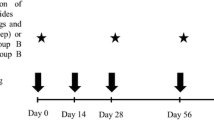Summary
The uncommon case of a mass outdoor occurence ofPulex irritans L. is described. Most probably, animal wastes introduced into soil, in thick layers, with a maximum depth of 5 cm, to fertilize certain cultivated plants, served as a nutrient basis. Obviously, the microclimate inside these fertilizer layers favoured a mass development of the fleas.
From a hygienic point of view, objections are to be made against the use of such organic fertilizer since a spreading and mass multiplication of fleas which are counted among vectors of diesease could be favoured by this.
To control the fleas a wettable powder containing propoxur was employed which otherwise is used not only in household hygiene but also as pesticide against noxious insects on plants. To protect cultivated plants, the preparation was applied with a concentration of between 0.5 and 1% and not with that of between 2 and 4% as customary in household hygiene. Since, however, preparations for plant protection. containing propoxur are applied with a concentration of between 0.05 and 0.15% only, a damage to cultivated plants had to be expected, with the concentration used in this case.
The 0.5% concentration applied in a quantity of 300–400 cm.3/m.2 resulted in a complete damage of young, one-year-old garden asters (Aster spec.), young gladiolus, some lipins, young garden-beans before bloom, three-year-old strawberries, young snapdragon plants and tomatoes in bloom. With the concentration and applied quantity as mentioned, orach, kohlrabi, Ricinus spec., older gladiolus, laburnum, some lipins, peonies and fennel (Foeniculum vulgare var.dulce) were damaged only partially. A complete damage of orach began within a few days after repeated treatment 15 days after the first one, when some sites (suspected breeding places of the fleas) inside the garden were again sprayed with a 1% concentration of an identical quantity. While, following this treatment, no damaging effect could be observed in rose standards it became evident in perennial asters(Chrysanthemum indicum) and dahlias. Even 30 days after the second treatment many other plants did not show any signs of damage.
The nuisance on account of the fleas having decreased considerably already within 10 days after the first attempt for control, the garden could be termed free from fleas a few days after the second treatment. Since the garden remained free from fleas also after a lapse of another 30 days, the killing of flea larvae in their nutrient basis by means of the propoxur preparation can be considered successful. In this connection the damaging effect on numerous species cultivated plants should not be overlooked.
Similar content being viewed by others
Literaturverzeichnis
Biologische Bundesanstalt, 1968: Pflanzenschutzmittelverzeichnis. Merkblatt Nr. 1, 21. Aufl.
Brauns, A., 1968: Praktische Bodenbiologie. G. Fischer Verlag, Stuttgart, 1–470.
Bundesgesundheitsamt, 1968: Verzeichnis der vom Bundesgesundheitsamt gemaß § 41 BSeuchG geprüften und anerkannten Mittel und Geräte zur Bekämpfung von Gesundheits- und Hausschä dlingen. Bundesgesundheitsblatt 10 (6), 87–92.
Martini, E., 1952: Lehrbuch der medizinischen Entomologie. G. Fischer Verlag, Jena, 4. Aufl., 1–694.
Peus, F., 1938: Die Flöhe. Bau, Kennzeichen und Lebensweise, Hygienische Bedeutung und Bekämpfung der für den Menschen wichtigen Floh-Arten. Monographien z. Hygienischen Zoologie, Bd. 5, Leipzig, 1–106.
Peus, F., 1952: Aphaniptera, Flöhe. (In: Martini, E., Lehrbuch der medizinischen, Entomologie, Jena) 4. Aufl., 161–182.
Peus, P., 1953. Flöhe. Die Neue Brehm-Bücherei, Leipzig, 1–43.
Rosický, B., 1957: Fauna CSR, Svazek 10, Blechy-Aphaniptera. Československá Akad. Ved, Praha, 1–439.
Smit, F. G. A. M., 1958: Fleas. Their Medical and Veterinary Importance. Brit. Mus. (Nat. Hist.) Econ. Ser. 3 A, 1–20.
Additional information
Für die Überlassung der Bearbeitung dieses Falles sei hiermit Herrn Dr. Kurt Becker, Wiss. Direktor im Institut für Wasser-, Boden- und Lufthygiene des Bundesgesundheitsamtes, Berlin-Dahlem, mein Dank ausgesprochen. Die Flöhe der Befallsstelle wurden von ihm eindeutig als Vertreter des Menschenflohes bestimmt. Für die Beratung in der Wahl des Bekämpfungsmittels und für die Durchsicht. des Manuskriptes sei an dieser Stelle Frau Wiss. Oberrätin Dr. Edith Döhring aufrichtig gedankt. Herrn Prof. Dr. Fritz Peus, Institut für Angewandte Zoologie der Freien Universität, Berlin, bin ich für wertvolle Hinweise hinsichtlich der Biologie des Menschenflohes und Herrn Dr. Miroslav Privora, Institut für Epidemiologie und Mikrobiologie, Prag, für die Übersetzung einer in tschechisch abgefaßten Literaturstelle über die Bionomie des Menschenflohes zu Dank verpflichtet. Die in der Tabelle 1 benutzten Temperatur- und Niederschlagswerte für Berlin-Rudow stellte freundlicherweise das Wetteramt im Zentralflughafen, Berlin-Tempelhof, zur Verfügung.
Rights and permissions
About this article
Cite this article
Iglisch, I. Ein ungewöhnliches Auftreten des Menschenflohes,Pulex irritans L. (Aphaniptera Pulicidae), im Freiland, und zur Problematik seiner Bekämpfung. Anzeiger für Schädlingskunde 43, 83–90 (1970). https://doi.org/10.1007/BF02049377
Published:
Issue Date:
DOI: https://doi.org/10.1007/BF02049377




